#The way it transitions from one shot to the next and between visual effects?
Explore tagged Tumblr posts
Text
Just saw the Black Swan trailer and I adore it. It's giving me very similar vibes to Blade and Kafka's trailers, in which it is very atmospheric, not afraid to play around with visual effects and certain cues in order to establish a feeling, very strong color choices like if you notice those trailers it seems like they're basked in certain colored light sources which I adore, and the music ties in so well with the video, managing to stand out while also not obscuring or taking away from what any of the characters are saying. I really loved it, I am WAITING for Black Swan's theme to be released in full to listen to, C'mon hoyomix where's that album. All around I just love it
There is one thing I'll say... and it's not necessarily about the trailer more about Black Swan herself and her design, and it's that I think her design and concept for me at least (very important to emphasize that this is based on my own taste and thoughts) would be like 10 times more effectively esp in conveying her mysterious nature if her eyes were obstructed. I do plan to explain that more in a later post, but yeah I think she'd fit the mysterious bill a bit more if her eyes were covered somehow
#Unlike a lot of other people#Don't mind her outfit much#I do kinda like the leotard look though I can think of what I would change#But I dunno#With her eyes fully visible face fully clear to see#She doesn't feel Design wise as mysterious as her motifs and her personality (so far) seem to be presenting#BUT AGAIN#LOVED THE TRAILRR#SO SO GOOD#The camera angles?#The way it transitions from one shot to the next and between visual effects?#In general the symbolism used in her trailer and for her character? I love it#A mix of kaleidoscope and stained glass and I love it#Along with so so much more#I'm so hyped#It's a shame I'm dedicated saving for Sam and eventual full SH team (and eventual e6 Blade) because I would otherwise pull for her#I'm so hyped for penacony AAAHHH#Black swan#Hsr black swan#Hsr#Honkai star rail
7 notes
·
View notes
Text
Well.
I guess I'm doing this...collection of observations from the autiomaa mv (i'm not going to call it an analysis) tonight after all 😅
So the mv starting out with a really short flash of the tear-illusion shot, then some short bursts of him in 2 locations in the mv, followed by a longer pan on a cracking facade...

The light effects on the wall look like being under water, which also kind of replicated by the fabric of his coat.
The following couple of scenes establish where he is - aimlessly wandering in some abandoned house - we zoom in intensely, almost uncomfortably close to his neck and eyes - he's making almost pleading eye-contact. He is wandering further, through the house, arriving at and entering
A staircase through a door, which closes after him.

To me, this signifies his decision to enter esc. The staircase can take you upwards - maybe signified by the lighted glass wall above. But what we see is not him confidently walking upstairs but being caught in that hallway, traveling up and down the stairs. He hasn't reached the upper floor and is caught in limbo. Alone with himself.
The therapist scene starts. He slinks in, hunched, making himself smaller than he is, drowning in his clothes. The session also takes place in a warehouse but it's set up in a way that it might as well be an interrogation.
He is pleading again - spilling everything out in the hope he's understood. However, what we see next is him talking/singing to a mirror image of himself. Either to signify he is talking to himself because the therapist doesn't listen and/or only he himself can truly understand and listen to his problems.

We get the photo scene - that one has been talked about at length

And that flash seems to start a transition in the video from where flashes were mainly used as separating element between shots to actually flashing on him physically and more relentless than before.
He is transversing more rooms and hallways - followed and faced by dozends of flashes from cameras, spotlights follow and corner him - he can't hide or evade.
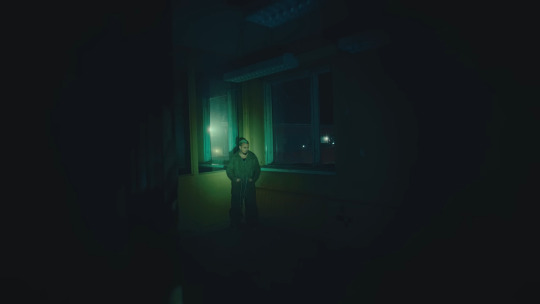
He keeps traversing hallways and empty rooms but he seems locked inside - restless and defeated at the same time - either visual for his mind that he can't open up about but also very much likely his real life situation not being able to leave the house in peace.
He longingly stares out of the window. This is where i'll stick my neck out and say they deliberately recreated the visual from his Vogue shot in profile. I can only speculate but to me, it's to put something into contrast, either between then and now/after or maybe between outside vs inside. I mean. Look at it:

We see him(?) as a shadow behind the upper floor glass wall in the light - he made it there after all but we/his mind is still watching from below and can't make contact with that person up above.
His dance moves get more and more erratic, a bit like someone waiting and slowly going crazy from it.
Watching the headlines with the therapist seems to upset him. They are projected in stark white and big - because they are important to him, because they are bigger than him or because he is watching his own life happening like a movie but not feeling any of it as real. Others can't relate to it because it's just too uncommon and crazy. He realizes this while looking at his therapist, seeing how could anyone ever get it who hasn't gone through the same thing - he'll not have a chance to get this across.

His dancing gets even more lifeless afterwards - almost swaying in a traumatized manner barely holding himself upright, especially after the therapist proves to be useless and making things worse even. (To me, it's not quite clear what the cigarettes offered by the therapist signify - pharmaceutical drugs/tablets? The only way out is returning to his old vices?)

We end a little like we started - with an intense stare into his eyes. They are not pleading. They know. They see. (They demand better.)
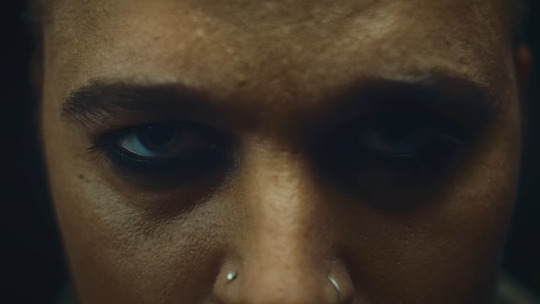
Aaaand that's it for now. (I'm sure there will be one or two ''AND ANOTHER THING!'' but i'd love to hear from you also!!!)
Thanks for listening to my TED talk <3
#käärijä#autiomaa thoughts#i do this#very curious what others think <3#god i hope he takes so much time off in 2025 :')#(let me know if i should rather put this under a readmore)
65 notes
·
View notes
Text
I've been feeling some kinds of ways since I finished Jedi: Survivor so I'm going to ramble some thoughts that other people have probably already had, about something that blew my mind as an extraordinary example of medium-as-storytelling. big honkin spoilers for Je:Su below.
So, "turning to the Dark Side" in SW is usually going to be a plot beat in the two primary forms that SW media takes, right: visual (movies, TV) or written (all the books, but also in fanfic). In both cases, as the audience, you're largely going to have to take the author's explanation for how it feels, why a character is doing it, and what the motivations are behind it. Even in visual media you're more likely to be told than shown, since it's established as an extremely internal, feelings-based experience for the characters. Because it's not a process replicable in real life, storytelling explanations for the difference between how light and dark side Force usage feels is going to have to rely on metaphor, and on the audience's willingness to engage in pathos. Which, to be fair, audiences are famously great at! There's been mixed results in SW media, but it's perfectly possible to make turning to the dark side a very engaging story beat that feels emotionally real and justified.
Then, there's interactive media. I'm fascinated by the storytelling potential of narrative games because of the different way they demand that the audience engage with the story, right, the way that physiological input from the audience changes the connections that the brain makes to the input it's receiving. The way having to press a button to make the next action happen manipulates the lizard brain into believing itself the cause of the effect, even though the forebrain understands that the story is just as predetermined as a published novel, so the button push is really not very different from a page turn. It's a potent tool for manipulating the audience's emotions and engagement, very easy to fumble but pretty mindblowing when executed well.
There were definitely moments in Survivor when I was like "ok am I going to be allowed to actually play this game some day" when control kept being taken away from me in favor of cutscenes. But as the story went on and I got into it, I stopped minding the times when my thumbs were still, and barely noticed the transitions between "I am making this happen" and "I am watching this happen." That's good narrative game storytelling, for sure. But it still felt like a good story that happened to also be a good video game, not quite meshing the two in a meaningful way. Until Nova Garon.
A lot depends on how you play this, I'm sure, but in my case I pressed through the end of the game from the last Dagan fight to credits in one sitting. Because of how tired my hands were from the physical demand of the Darth Vader fight, and because I had been maining blaster stance for much of the game, I made a semi-conscious choice when I reached Nova Garon to use my saber as little as possible. I one-shotted a lot of unarmored officers from across rooms, having decided that Cal felt cold with rage and tightly coiled, so it would make sense for him to not even give these people the honor of being killed by a lightsaber. So I'll grant you that I was adding my own hot sauce to the delicious angst recipe the game had already made for me.
Then you get to Bode and have a really long cutscene that doubles down on the idea that Cal's anger is, at that moment, cold. He's tightly restrained. For several back and forths in the conversation he even still tries to be neutral in front of Kata.
So, for me at least, it REALLY fucking worked as a storytelling move when Cal explodes. Bode runs off, you chase, and the very first thing you're faced with is a room packed with a comical amount of enemies, the kind of melee scrum you've been trained by the mechanics for the whole game to approach with a whirlwind lightsaber freakout using either double-bladed or dual stance, ideally using Slow to buy some time. I had truly played into the game's hands like a fool here because I only had blaster and single stance as options at the time. So I'm looking around my screen in that split second, considering my stance and Force and slicing options, prepared for punishment, barely registering the notification scroll on the right side of the screen because a whole bunch of new databank entries get dumped by the Bode cutscene - the last one of which is, iirc, 'Kata Akuna.'
So Kata Akuna fades upward and is replaced by the same size white text, relatively small, suggesting a button press to you, like it's done a dozen or more times before to say stuff like 'press O to dash' or 'press R1 to tame the creature,' relatively benign things that are always very useful tools that you use over and over and over as soon as you gain them. Except it says 'press [button command you already know and have internalized as your most powerful Force tool with the longest cooldown, which you were just thinking about using] to have Cal embrace his darkness.'
And like, the phrasing is fascinating to me there. It's always fascinating to me how anyone talks about playing a video game, anyway, like "I just beat Ganon" or whatever instead of "Link just beat Ganon," because of course you feel ownership of the actions of the protagonist of a piece of interactive media in a way you rarely feel ownership of the actions of anyone in a book or movie. Previous button instructions in this same game have said 'press [blah] to do [thing]' without a given addressee, leaving the player to probably interpret that, unconsciously, as the unspoken 'you' that is typical in English grammar. 'You press O to dash.' 'You press R1 to tame the critter.' But - 'press [dah] to have Cal embrace his darkness' is so - unsettling and offputting, separating you, player, from Cal, protagonist - and it's occupying a VERY important space because the buttons its asking you to press are ones you already probably wanted to press, but instead of doing the thing you wanted it to do it's going to do some kind of new, horrible, unknown thing that is almost certainly going to be bad for Cal.
Then you press it, because you have to, and it's the best fucking shit that's ever happened to you, the player. It jumps your level by 10, instakills half the people in the room, makes you fast and powerful and nigh unbeatable. Depending on what difficulty you've been playing on, it may make a combat encounter that looked like a surefire several-deaths-in-a-row run into something as trivial as a roomful of bugs. It lasts an insanely long time. It's godmode. It's a broken mechanic. It makes your screen bleed. The unbridled glee that you, the player, probably feel while killing that room full of people is at stark odds with the circumstance you are in, storywise, because you are supposed to be feeling grief and rage and driving urgency to hunt and catch your fleeing enemy. But instead you have a moment in this room of, if you're like me, hooting and hollering while doing a big old war crime, just because it's suddenly easy and fun.
It took me a couple more 'embrace the darknesses' to realize that Cal only has one stance in that mode. Anything you've learned before is thrown away - earned skill ditched in favor of brute strength. And I didn't really care? Even though I did really enjoy how skilled I had gotten with my favored stances, because the combat in Survivor feels really good, and also I knew they'd be back after no more than 2 minutes in dark side mode. So even though I didn't get to do the moves I'd spent so long mastering, every 'embrace the darkness' was a little indulgence of having my cake and eating it too. It started to feel like an insta-win mechanic against any enemy of a low enough level, and a safety/turtling mechanic against slightly more difficult ones. I wanted to trigger it as soon as the cooldown ended even when I didn't need to, just for the fun. I felt safer having it available.
And all of that - as a mechanic - is the single most compelling depiction of the Dark Side that I've ever seen in a piece of SW media.
The way it shows up as an understated suggestion in your periphery. The way it cuts through every Gordian knot in front of you. How fun it feels, how unfair it feels, how safe it feels to have it on your side. As a game mechanic it places the audience in the position of actually feeling what before only metaphor could attempt to describe - the way turning to the dark side is all about letting go and letting loose. Being a nuclear reactor mid-meltdown. Laughing and button-mashing and going "oh no, oh shit, I shouldn't be doing this" but not stopping. And also, as the player, your mind is not clouded by any mysterious outside control - you're aware of what you're doing, you're aware you're making choices here, you could definitely stop using the mechanic after the first instance where the game has to put a finger on the scale for a moment to teach you the controls. And maybe you do make that choice, idk how you play. But you get through the massacre and at the end when Merrin asks Cal not to kill one last person, and Cal agrees, it doesn't feel cheap? It doesn't feel like Cal 'snapped out of' anything. It doesn't feel like there was anything for him to snap out of, because he, like you, has just been making these choices for room after room of enemies, and frankly no one's been around to ask him to stop before now. He still seems reasonable, and so a reasonable request by someone he cares about still reaches him.
The Dark Side isn't the grief, pain, suffering, anger, etc. It's the release from those. And this one moment of a game mechanic explains that so powerfully and succinctly, in a way that other mediums can't replicate. It's one of the the best uses of a medium in the service of the story since House of Leaves. It's still making me have to lie on the floor and stare at the ceiling weeks later.
There's more to say about how the menu screen changes once Cal's embraced his darkness, altering his internal landscape in a way that doesn't change what you have access to but which can never be unseen. About how 'Slow' as a mechanic is gone forever, the most powerful Force ability Cal had just eradicated by an imposter version (a better version, the insidious inner voice wants to say). About the dramatic, overwhelming way the game chooses to command you to embrace your darkness next time, when the whole screen goes red and black. And the phrasing is different there, too, not 'have Cal embrace his darkness' but just 'embrace the darkness,' because this time you and Cal are not being treated as semantically separate entities. The first time, it's like maybe Cal wouldn't want to, so you, player, have to be the little Sithy whisper in his head that makes him do it. But the second time, Cal wants to do it so badly that his desire to embrace the darkness overpowers your, player's, agency to attempt to make any other choice. Even if you could have won that fight another way, Cal didn't want to win that fight any other way. He takes away your UI until you free him into his darkness, release him from his complex suffering into the simplicity of power.
It's just so fucking good, okay. It's such good storytelling, structurally. The way the player's choices and Cal's actions are on a surface level one-to-one correlated but actually form this intricate internal conversation. Using the most important thing a video game can be - fun - as a tool to describe a very dark place that anyone might go to internally, whether in a reality with space magic or not. But! Not by doing the thing that's been done before, the old "you [consumer] should feel bad because your act of consumption made the characters feel bad" fourth-wall-breaking meta thing that shames the reader for being entertained by others' pain (aka experiencing pathos, an extremely normal and not-shameful thing for humans to do). Survivor uses the audience's enjoyment of the medium against them narratively, in a gleeful and not-shaming way I don't think I've seen from media before, and I love it.
anyway I have no big conclusion here, I just am a writer who gets impressed when other writers do good writing. props to Respawn for making me writhe in my feels.
#jedi survivor#jedi survivor meta#fandom meta#sf writes#just sf rambling about stuff that academics have probably already said better#have cal embrace his darkness#dark side star wars shenaniganry
25 notes
·
View notes
Text
Visual Effects in Only Friends MV part 2
The second song on the Only Friends OST dropped today; So What? by the amazing Ford Arun. Much like the first MV for Only Friends, this one is also has visual frameworks that made me stop and stare.
youtube
Just like my first post on this subject, where I talked about the late 90s/early 00s aesthetic of the show as well as controlled voyeurism (aka we only see what they want us to see), these themes show up again here, but a little differently. Unlike the Let's Try MV and the BTS vids which use multiple different effects and transitions as well as framing a lot of the scenes to look like (possibly) 90s camcorder footage, So What? has two visual effects (I think technically three, and I'll point out why I say it this way in a minute).
The first one is the camcorder footage effect. Except that it's even different from the Let's Try MV. While the Let's Try MV has the "play" prompt onscreen and time stamps, it now, to me, feels more like CCTV video than camcorder video. The video effect on So What? is definitely camcorder footage because it is time and date stamped.
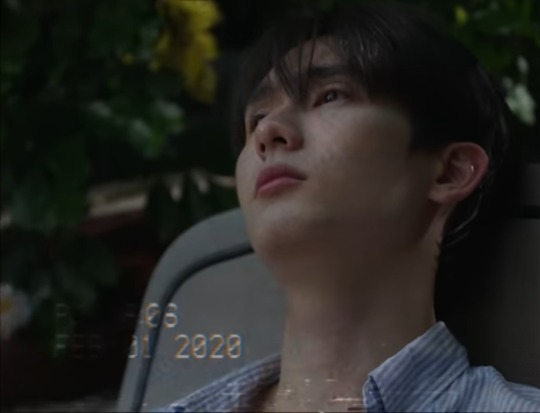
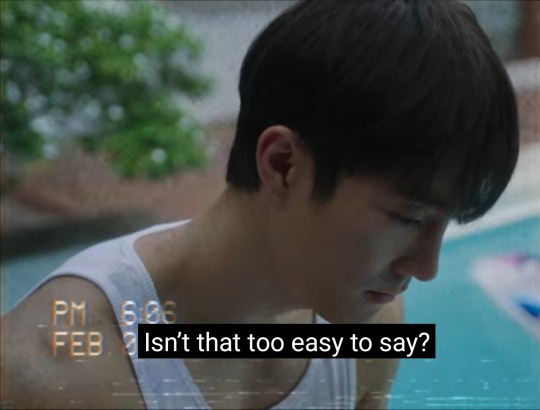

Now, the time and date stamp is February 1st, 2020 at 6:06pm for every screen it appears on, which to me cannot be an accurate date/time for any of the scenes. Several of these scenes were from episodes 4, 5, 6, or potentially yet to air. Chuem drops info about Covid in episode one and in February of 2020, we were so early into the pandemic during that time that I'm not sure she would have referred to it so casually, plus with no Covid precautions being taken onscreen it does feel the show is set currently (aka 2023).
Why this date? Why 6:06pm? WHAT IS JOJO TRYING TO SAY HERE? Is this a specific reference to something upcoming on the show? Is this date famous in Thailand for something? Did he just pull a date and time out of a hat?
Onto the second effect: the yellow text on the screen is back! It was heavily used as a visual effect in episode one, and after a discussion with @ignoranaxed I did add it to my Narrative Frameworks post where I'm tracking visual effects on the show. We discussed whether or not this was an homage or reference to SKAM Norway, an extremely popular coming of age teen drama that had an amazingly done queer season (Season three. If nothing else, stop what you're doing and go watch SKAM Norway season three. You can thank me later). The show was so popular it has been remade in Spain, Italy, France, Germany (named Druck), Belgium (named WtFock), the United States and has even been announced as a Korean (BL?) drama for next year.
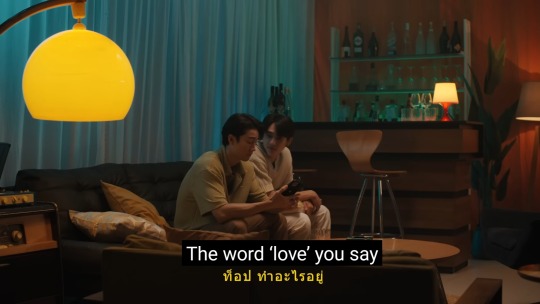
Is this an actual homage? I came down on the side of maybe. I can't swear it is, but I can't say it isn't. That yellow text on the screen is iconic due to SKAM Norway, and it is used in every single remake of the show (if Korea doesn't use it, I will cry. Also, if Korea doesn't release/air it in the same way, I will cry). Leaving that aside, the yellow text is in Thai, and as yet, I have no idea what it says because my subs only translated the song lyrics, not the onscreen words. If anyone who knows Thai can help me with this, I would love you forever because there's one other thing that shows up in yellow on the screen, and it's this:
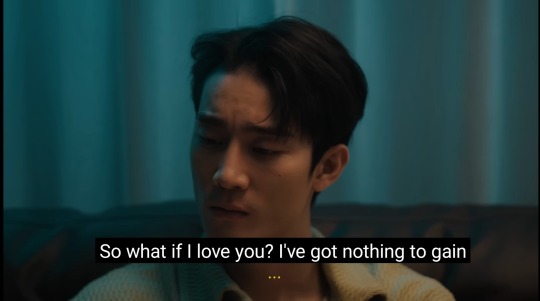
WHY AN ELLIPSES, JOJO? WHAT DID IT SAY BEFORE THIS? I NEED TO KNOW WHY IT'S TRAILING OFF. IS IT TO BE CONTINUED? THE NOT KNOWING WILL DRIVE ME INSANE.
Onto the third , but maybe not really an effect: Is Ford photoshopped in here?
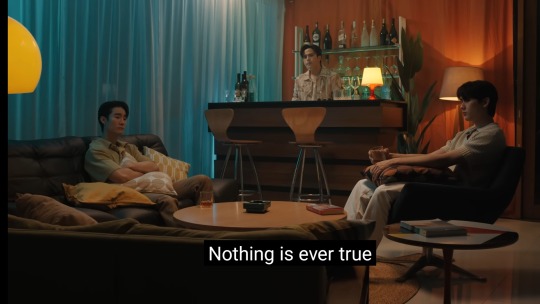
I ask this because if he is (and I can't quite tell but I think maybe?) then does that mean this is future footage coming up on the show? Or, like Let's Try MV did with it's extra SandRay footage in the car, was this just shot for the MV? I'm curious to see what people think on this.
Now for the rest of the MV where I just melt down because WHAT THE FUCK IS THIS DRAMA BETWEEN YO AND PLUG, JOJO? YOU CAN'T DO THIS. Also, is this Sand hugging Yo?
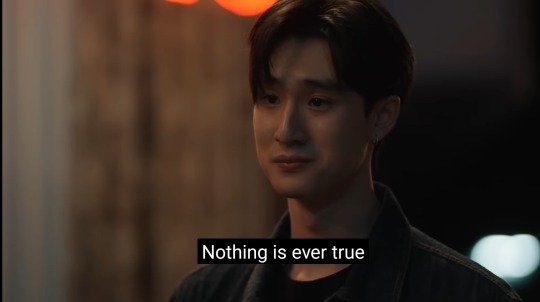
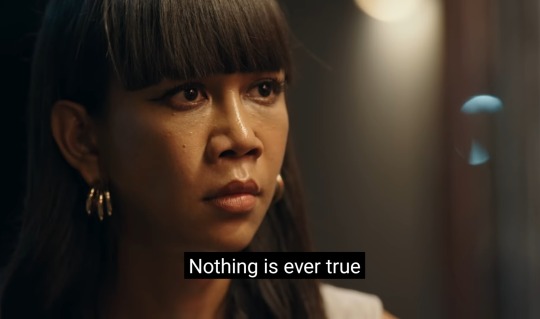
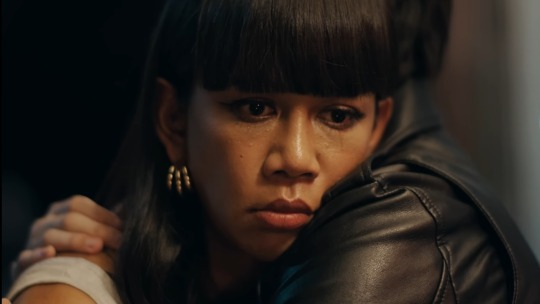
You can't do this to my girl. This will hurt.
Do we think this is Boston and Nick potentially going ice skating or roller skating? Because if it's roller skating, JOJO I WILL LOVE YOU FOREVER.

In summary, the visual frameworks are back in play once again and what they're choosing to show and how feel important.
Tagging the ephemerality squad: @waitmyturtles, @wen-kexing-apologist, @ranchthoughts, @chickenstrangers, @lurkingshan, @twig-tea, @clara-maybe-ontheroad, @distant-screaming
Apologies to anyone I missed. If you would liked to be tagged in my OF posts/meta, please let me know and I will add you.
55 notes
·
View notes
Text
Shot 16 - Approach on FX Animation
One of the shots I needed to construct was a scene where the beast bolts out almost like a lightning trail, moving from one bush to another. I wanted to stage the shot from above, with the camera following the beast and transitioning smoothly into the next sequence. The layout for the background turned out well, so my next step was to start working on the bolting animation itself.
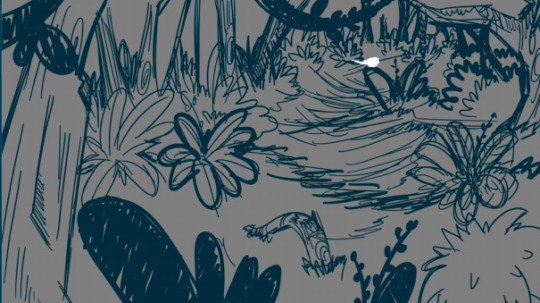
Background layout that I locked
A classmate recommended that I check out a few 2D FX artists for reference, particularly Quentin Cordonnier and Sahil Yadav. I visited their YouTube channels to study how they animate effects and what makes their work look so visually impactful. In one video, Quentin explained the contrast between the core burst of an effect and the moments that follow. He uses a quick burst of ones to animate the impact, then shifts to twos, threes, or even fours to let the aftermath settle in. Even though I’m not animating smoke, understanding this principle of timing contrast helps me decide where I can apply a similar rhythm in my own FX animation.
youtube
Quentin's Tutorial on animating FX
Sahil’s animation is much closer to the kind of effects I want to create. I observed how he combines camera movement with animation to create powerful motion. There are fast bursts that lead to a striking pose or frame that holds just long enough before the filler animation bridges the motion. His drawings move in a way that makes them feel fast and energetic, always heading toward a clear destination. He also adds supporting elements that move differently from the main trail. For example, if the main trail moves horizontally, the sparks or smaller effects might move vertically around it. These supporting elements play a key role in defining the nature of the effect, whether it’s fire, smoke, electricity, or something else entirely.
instagram
Breakdown from Sahil's Instagram
With those insights, I began applying some of these techniques to my own shot. I think I managed to capture the sense of speed with leftover sparks that enhance the visual punch I was aiming for.
Rough pass of shot 16
However, I still want to improve the contrast in timing for future passes during the tie-down stage. For now, this serves as the foundation for a shot that will play a key role in driving the story forward.
References:
Instagram (no date b). https://www.instagram.com/p/DDUwe6kSqNf/.
The SPA Studios (2024b) How to ANIMATE a 2D FX magical explosion. https://www.youtube.com/watch?v=mmKOizI73PM.
#2d animation#reflection#visual development#2d art#animation#short film#youtube#instagram#Youtube#Instagram
2 notes
·
View notes
Text
Rat Cosmos
Here’s the cave dark purple with smoothly curved walls open air above blank void floating red cubes. Red cubes glowing softly, rotate on move. Rare event known one in sixty five thousand five six five or thereabouts. No effect of global interest but still draws attention. Walk back and forth and cubes rotate in sync. Self interlocked with local environs depersonalization of interest wrt larger thematic purpose we consider the rarity and inexplicability of the event as signal Yume Nikki no 3D space Dream Emulator yes why here though not certain to be determined by following scenes. No mobs. Long tunnel strictly linear. Look mismatched texture right forward and below. Lower. Yes item pressed inelegantly against wall otherwise invisible. Borton’s Club collect. Plus fifty-three lightning interesting possibly pricey no use though as running strict Purity build need wisdom minmax. Can’t spare for whimsy in primary weapon slot. Other statistics nominal. Bottom of bag.
Keep going down cave longer than expected bored try to move faster now ignoring red cubes. Next sudden transition all white. No shadows consequently distance to walls cannot be determined. Tunnel one end brown door other, termina provide only positional grounding. Luckily straight shot. Hidden spatial information means likely secret. Press against walls and stare at tunnel exit watching for sudden slip of movement, move back and repeat, continue motion across one wall. Found nothing same other wall. Halfway through slip and tunnel exit no longer visible found it. Unfortunately now termina hidden by secret maze wall no longer capable of visual positioning. Move by touch. Small area and so quickly encounter a fairy.
Orange head green body. Says nothing but offers integration fourteen p at forty-eight percent. Dilemma. Fairy silence is ambiguous could be oblique nature or simply shy but more likely the former given hidden maze location. Check p, over one hundred twenty but painful finitude sense regardless no over one hundred twenty means hoarder instinct to be resisted. No fairy in seven plus hours means unlikely to find better options any time soon. Still ambivalent oblique fairy will be a nuisance until minimum three hours and might be dead by then anyway. Seven plus hours with no fairy contained pleasant simplicity realizing general dispreference. Might be a mimic fairy no mimics can’t have orange head. Decide against and walk backwards lack of visual positioning worse on the way back. Several minutes of bumbling between walls eventually catch tunnel exit. Other direction towards brown door.
Move to open door STOP shuddering effect black haze on edges circular particles drifting inward towards visual center. Garbage zone. Only single use poison cures and risk long vertical drop no means of spatial anchoring. Risk of bag golems. Low mood not ready nothing to really look for down there. Bag golems drop brown helmet twenty percent chance and higher wisdom than current but could likely purchase better within the hour w/ profits from lightning club. Turn around back down white corridor towards red cube tunnel.
Tunnel feels longer. Cube rotation angle may have changed but hard to tell. Suddenly need purpose. Where am I. Goals meanings goals. Purpose. Trying to maximize purity build for Fralzago. Higher. Higher. Check progress. Sixty-one percent. Higher. Higher. What is this where am I. Why. Phenomenal experience precedes conscious desire. Meaning inherent in ongoing production of sense-data. Sight sound touch motion. I am only shepherd. Higher. Higher. Wait no lower. Check progress. Sixty-one percent. It was sixty-three yesterday. Backsliding somehow. Something possibly lost stop in tunnel and check. Check. Check. No nothing lost all progress at expected points but additional requirements have been added. Dammit. All is obligation. Skim additional requirements but nothing severe likely to be fulfilled in natural course of events, still pained by backsliding. Speed up to compensate. Must be more efficient.
End of tunnel now return to red docks. Torches at regular intervals hung unsuspended above regular wooden texture but large intricate surface geometry when seen from above. Easy to get lost luckily nothing to do now but retrace steps. Ghosts flit by pay me little mind I return the favor. Proud. Non hostile ghosts difficult to maintain requires careful resource management up to approx twenty percent too easy to slip in managing cultural codes but well worth it never forsaken and well scaled trade. Yellow ghost I say hello it says yes I ask price for lightning club but no interest limited selection mostly tinctures and single use herbs I say thank you it says pleasure to make your acquaintance. Limited conversational options means likely non recurring. Loading zone soon as I approach boat and it will cease. Sad little creature I consider buying something to commemorate its existence but already in other direction not worth turning back too late now anyways there will be more yellow ghosts.
Boat slower than usual but nevertheless I choose Triania at ten point zero miles not Myceliorum at seven point four miles despite greater distance need a larger city at this dreary moment. Boat man elderly possibly early stage senility. Ask questions. Question one how long have you been working these docks question two do you have any kids question three have you ever considered getting into astrology question four where do you live spots contradiction. Question one answer forty three years since moving south but question four answer Doghouse Grove born ‘n raised ‘n gonna be buried there but Doghouse northwesterly one hundred thirty one latitude too far to be coincidence confirms early stage senility. Continue motion in silence.
Check progress again. Additional requirements more cumbersome than initial read incl. two kills in a row without weapon obviously expecting astral projection exploits will be unbearable to set up certainly easier with oblique fairy dammit dammit could be worth turning around. Maybe. Nevertheless continue slow boat ride lacking rational cause. Just not another long walk purple tunnel red cubes. Slow dreary want action. Where am I. Stop ask again question three. Skimmed previously but answer longer than expected. Same answer second time lucky early stage senility mitigates refusals. Old man says used to imagine astrology containing depths of beauty but preferred the imagining to the searching and so no attempt to practical application. Details of imagining forgotten leaving only imprint of lost fantasy like tears in rain etc. “Desire only the feeling of desire.” And folly of youth only now age perspective loss etc. Conventional conclusion for male boat drivers homogeneously depressive character. Still surprising length multi paragraph deliberate carefully sincere maybe autobiographical. Who is this talking. No name.
Seems increasingly slants towards desirelessness theme in conversation when exiting from red docks not matching all past data points so maybe noise but could be weighted random. Possibly overthinking. Red docks bleak sort of place transitional to hidden or esoteric as in the seen red cube and white hall events but alternative possibilities blue staircase and fallen bookshelf events similar in nature. Symbols suggest bleakness as precursor for insight or invocation to reach the unknown but spoils of exploration relatively bland one club and missed oblique fairy ultimately falls flat other areas do better six out of ten. And fucking garbage zone bag golems could have gotten lucky and rosemary island instead. If rosemary island and chance boot drop twenty three wisdom or higher could have Fralzago fight by now. Cruel fate to be rendered asymbolic. Deceleration. Where am I.
Finally in Triania thank you choose effusive over polite no good with subtlety for the old man in early stage senility. Large tip twenty five percent why not. Check time three AM and two. Rain appears in brief flashes against the white of windows in apartments but only light showers ground not damp and disappears against skin. Aimless wander. Need to be more efficient. Check need for sleep still rested from unconscious maintenance of various exhaustion management exploits must have been doing it on boat and in red cube tunnel while distracted. Still might be worth three to four point five hours at the very least a dream would be nice. Sell lightning club first. Spot apothecary. Serendipity.
Apothecary takes lightning club one hundred thirty three point three percent asking price claiming personal historical interest in Borton. Canned response stretches suspension of disbelief if these generic goods hawkers are to be believed half the city has personal historical interest in every single person who ever had a club named after them. Purchase tincture of blue mugwort. Buy one get one free. Accept. Walk outside turn to next store offers mechanical parts sell second tincture of blue mugwort for tiny profit hardly worth the opportunity cost. If you spot and pick up a penny on the ground the efficiency cutoff is approx 3 seconds past which point you would have been working for less than minimum wage. What is a penny.
Hotel for sleep. Drink blue mugwort effect sleep skip to REM next eight hours. Low quality taste expect seventy to eighty percent effectiveness given canned response in apothecary. New hotel visible in distance aiming for thirty hotels slept in total. Six of eight cleared in Triania chose bigger city for this and similar. Cut through alley, mugger. Blue orb blue orb. Small profits dropped knife. Ignore not worth clutter. Two more muggers but they run. One has blackened knife could kill take melt knife later for liquid obsidian. Check bag two liquid obsidian want five or six worth it. Look back muggers gone oh well. Revisionist instinct reframe as conscious mercy. Kindness to spare cowardly muggers. False. Muggers are killed but they do not die. Cannot have mercy without consequence.
Near hotel, step in mud. Slow for thirty seconds. Approach front door becomes glacial pace. Where am I. Retrospect red cube tunnel as subject of future dreams. Unlikely given last slept four days ago more fruitful materials available for unconscious regurgitation. Forgetful of details. Could be nine fire elementals altar of globes was ten AM and two nights past. Three AM and twenty four now so approx sixty five hour distance. Or something better but lost in memory fragment bubble. Blue mugwort tincture produces false lethargy intermittent bursts. Side effect not listed slipped out of mind. Will persist after wakeup could extend sleep. Can’t can’t can’t need to be more efficient. Dammit. Dispiriting but limited serious impact can push through. Unpleasant morning ahead. Already in elevator room ninth floor. Desk conversation automatic benefits of conversation in hotel strictly limited. Unable to encounter credulous or clueful options in hotel desk conversation tree. Could have encountered political. Many other chances for political in Triania.
Enter room wall texture identical to outside. Lazy. Ablutions and attempt ritual contact of tarantula goddess. Extraordinarily unlikely hail mary even repeated across months but quick ritual only two minutes. Reach in bag access discarded webbings burn with lighter scatter around mirror. Say the words. No room for decision in ritual invocation. Wait twenty seconds. Wait. Wait. Wait. Wait. Wait. Wait. Nothing. Disappointment muted by repetition. All for the best as answer whether to kill tarantula goddess still uncertain heard venom staff weakens every year. Eventual summoning unavoidable but multiple behaviors compatible with progress. Where am I goals meaning goals purpose sleep soon. Sleep now.
Sleep now. Blue mugwort hypnagogia direct into REM shuddering jolting sensation goes into red blue bubbling white white. Red cubes. Now time the intravenous arrangement get off my skin get off off you own this hold up IV bag fluid this is yours plus two in the bag. Need to work out twenty three plus seventy three ends in six eighty ninety but what question but forgotten means the butterfly count is off. The butterfly count is wrong too many. They swarm my head. Circle eyes grab one two more appear. “They lift me up in mercy”. What is above. Look but can’t. Eyes cast downward funeral procession. Who is dead I cannot look up to see. Why do we mourn when there is no more death. Someone up front stands at podium has the answer I approach. Looks so serious and this must be a punishment. Mourning is a curse that precedes death he grins wide and his pupils expand to fill his eyes and it seems he should be laughing but he does not so I laugh for him but it does not sound right he can see my laugh is false and his would be otherwise so I try to laugh lower or higher but still wrong and he reaches sharpness in bladder wake up.
Shamble to piss. Look in mirror. Looks alive. Shamble to piss but something is wrong. Not a hotel bathroom too dirty. Check mirror again. One hundred and forty four crisp frames per second. Can’t piss. Look down no lower body. Disintegrating upward soon nothing below shoulders. Not awake still dreaming. Red cubes in the mirror. Move and they rotate see self reflected in local environs. Red cube comfort dissolves nightmare. Only sleep. Phenomenal experience sight sound taste motion. Color. Purple tunnel red cubes. Color. Color. Only dreams. Watch texture on wall. Shape and geometry. Sudden clarity says sleep for approx three point five hours to maximize. Even in blue mugwort tincture REM dream modality there is no escape from clarity. Purple tunnel red cubes. What is being maximized.
3 notes
·
View notes
Note
How do you come up with the compositions for your comic pages? They look soooooo 👌
short answer is: i hardcore wing it
long answer: i have a very hard time visualizing things in my head. i go into something knowing the list of things i want to communicate and try to construct something thats aesthetically pleasing while accomplishing those goals. i personally think that its very good for me: i never feel bad for not reaching some insane standard in my head, because theres no standard in there. i just ask myself if i checked all the boxes on my list and if the page(s) look good, and if i did im satisfied!
as for page composition itself, thumbnailing is a super important part of the process for me. it helps me lay out not just the panels, but also the speech bubbles. never ever ever design a page and think you can add the speech bubbles wherever theres negative space: a comic is just as much words as it is art; treat them as equals.
i like to do thumbnails in batches (at least to the end of a scene) so i know how things flow together and i can ensure that the scene ends at the end of a page, and what pages are on an even or odd page (this informs the placement of page turns, which are very important when it comes to comics. theyre one of the few bits of control a comic artist has over their reader: the reader can turn the page whenever instead of having media happen At them as an a show/podcast. The reader controls the story and its flow in a sense. however, page turns reef control back from the reader and force them to engage with the author on their terms: you may get to control WHEN you see what comes next, but you do not get an inclination as to what that is. you allow them to subconsciously build up the the change/shift in space/jump in time in their head as a scene ends, or the suspense of what could be on the next page if your scene is dramatic. very important both for doing shocking scenes, but also for differentiate between soft and hard scene transitions.)
im also very careful to minmax the number of panels i need to execute a scene. use the minimum number of panels to communicate the most information possible. when i was first learning to comic way back in my syrup steals days, i had to teach myseld to not clutter a page with smaller panels (this was an especially frequent issue with eye panels. i looved having a small panel at the corner of a larger one just showing a characters' eyes reacting. while effective in small doses, this clutters up your pages like crazy). you have to be comfortable leaving things implied and trusting your audience will get it.
i also do not fuck around with establishing shots. even a lot of professional comic artists will only use them at the beginning of a scene and typically its just one big wide shot, which works for movies where scenes are in motion (motion inherently implies space better than a still image), but not so much for comics. i think its both more engaging and informative to microdose on establishing shots at all times. one establishing shot will never be enough to describe where characters are fully. i think its good to get in the habit of treating environments like characters themselves: you want everyone to see every angle of your oc? do that with your environments. it both breaks up the monotony/prevents you from shot-reverse-shot-ing, and also provides a lot of visual information about the space a character is in (and gives lots of opportunities to foreshadow!). this is especially important to do in action scenes: it is so damn easy to lose where a character is in a fight scene, to the point where it just becomes visual noise. you NEED the space characters are in to be well-established before and during a hectic scene, or readers will get lost and be unable to fill in the gap.
of course you need to be efficient here as well: minmax your panels! do establishing shots while characters are talking! explore the space in interesting ways even when something not that visually interesting is going on!
really, the constant dynamic establishment of location, minmaxxing of panels, and equal treatment of panels and speech bubbles are what i think are the most important things when it comes to page layout. this sort of became an Angs Guide To Comicking lol, but i tihnk its useful information. thank you for asking!!
2 notes
·
View notes
Text
Jake Seal Reveals How Tech Is Redefining Green Cinema
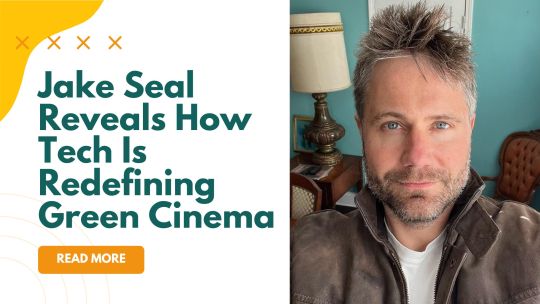
The film industry is in the middle of a much-needed evolution—one where technological innovation and environmental sustainability are no longer separate paths, but deeply intertwined. As studios and creators around the world face growing pressure to reduce their ecological footprint, a shift toward greener, smarter filmmaking is taking hold.
One industry voice has made it a personal mission to drive this transformation by fusing advanced technology with environmentally conscious practices. The result? A new blueprint for filmmaking—one that’s efficient, forward-thinking, and kinder to the planet.
Virtual Sets, Real Impact
Traditionally, large film productions have required massive physical sets, significant travel, and fleets of diesel generators—each contributing to a sizeable carbon footprint. But with the rise of virtual production technology, those practices are rapidly becoming outdated.
With tools like real-time rendering and immersive LED volume stages, entire worlds can be built digitally—eliminating the need for transporting large crews and equipment across continents. Virtual sets save time, resources, and emissions, all while offering creative flexibility that would have been unimaginable even a decade ago.
This isn’t just about flashy new tech—it’s about rethinking production from the ground up. By cutting down on wasteful logistics, filmmakers can reduce environmental harm without sacrificing visual storytelling.
Clean Energy on Set
One of the most exciting developments in green filmmaking has been the transition from fossil fuels to cleaner energy sources. Some productions have already begun using biodiesel alternatives like repurposed vegetable oil to power equipment and generators. Solar-powered mobile units and battery-powered LED lighting systems are replacing their energy-intensive predecessors.
These changes, while seemingly small on paper, can dramatically reduce carbon emissions during the course of a single shoot. More importantly, they demonstrate that clean energy and professional-grade production are entirely compatible.
The Paperless Office Revolution
Behind the scenes, production offices are also undergoing a green transformation. Scripts, call sheets, and shot lists that once relied on paper are now distributed digitally via cloud platforms and tablets. This not only saves trees but also reduces printing, waste, and unnecessary transport between departments.
It's part of a wider push toward modernizing production workflows through software and smart systems—making every part of the process leaner, faster, and more environmentally responsible.
Educating the Filmmakers of Tomorrow
The push for sustainable film practices is also being woven into education. Through collaborations with film schools and institutions like Canadore College, this vision is being passed on to the next generation of filmmakers. Students are learning how to work with virtual sets, energy-efficient tools, and cloud-based collaboration platforms as part of their standard training.
By exposing young creatives to both modern tech and eco-conscious thinking, the goal is to shape an industry that doesn’t have to choose between innovation and responsibility.
Tech as a Tool for Better Decisions
In this new model, technology isn’t just a replacement for traditional methods—it’s a tool that enables better decisions across the board. AI can optimize production schedules to reduce idle time and power use. Smart location scouting can be done virtually, avoiding unnecessary travel. Even post-production is going green, with remote editing setups replacing energy-hungry studio systems.
Sustainability isn’t just a moral decision—it’s proving to be a smarter, more cost-effective way to make films.
A Vision for the Future
What’s clear is that the future of cinema doesn’t have to be a choice between spectacle and sustainability. The two can go hand-in-hand when the right technologies are embraced with purpose. Cleaner sets, smarter workflows, and environmentally conscious choices can—and should—be the standard moving forward.
As the industry continues to evolve, the goal is simple: to tell powerful stories while protecting the world in which those stories are told. And with the right mix of innovation and responsibility, that future is already in motion.
#GreenFilmmaking#SustainableCinema#FilmTechnology#VirtualProduction#CleanEnergyOnSet#EcoFriendlyFilmmaking#FutureOfFilm
0 notes
Text
Week 12- Editing
This week we learned about the intricacies and key elements of editing. Let’s dive right in!
Editing is the process of selecting, arranging, and timing shots to shape the narrative and emotional flow of a film. It controls pacing, builds rhythm, and creates continuity between scenes. Through techniques like cuts and transitions, editing can intensify drama, reveal character perspectives, or guide the audience’s focus, making it one of the most powerful tools in visual storytelling.
There are 2 editing systems:
Continuity: a system of editing where time and space are consistent, and events happen in a chronological order of timeline.
Non-continuity: a system of editing where time and space are disrupted. The timeline can skip forward and backward in order to shift between different contextual backstories.
Editing includes:
Cutting
Straight cut:
A straight cut is the simplest, most common form of editing. It’s when one shot seamlessly jumps to the next, making the transition feel natural. It keeps the flow of the story uninterrupted, letting the action speak for itself.
Shot/reverse shot:
This technique often happens in conversations. We see one character talking, and then we cut to the other person’s reaction, creating a sense of dialogue and connection between the two. It’s like a visual back-and-forth.
Eyeline Match:
An eyeline match shows us what a character is looking at. When we see them glance in a certain direction, the next shot usually shows what’s catching their attention (can be an object or a person) helping us understand their perspective.
Graphic Match:
A graphic match connects two shots based on visual elements, like shapes, colors, or patterns. It creates a seamless transition from one scene to another, even if the objects or environments are entirely different, making the cut feel more artistic, unique, and interpretative.
Action Match:
With action match, the movement in one shot carries smoothly into the next, as if the action continues without interruption. It helps maintain continuity and makes the scene feel fluid, like when someone moves from one place to another and the next shot picks it up exactly where it left off.
Jump Cut:
A jump cut skips over time or space, jumping ahead in the action. It can feel sudden or disorienting, but that’s what makes it effective; it breaks the usual flow and can add tension, surprise, or urgency.
Crosscutting and Parallel Editing:
Crosscutting cuts between two or more scenes happening at the same time. It builds tension by showing different perspectives of the same event. Parallel editing is often used to show two separate but connected actions unfolding simultaneously, which can increase suspense or show contrast between characters or events. This helps the audience connect different scenes of a story.
Insert:
An insert is a close-up shot that highlights something important, like a character’s hand gripping a key or a clue on the ground. It directs our attention to a small detail that might be crucial to the story or a character’s journey.
Transitions
Transitions are the way we move between shots. They are essentially the smooth links between scenes that help the story flow naturally. They keep things from feeling abrupt and guide us through the changes in time, place, or mood. A good transition makes the whole experience feel connected and easy to follow. Some examples of transitions include dissolve, fade-in, fade-out, wipe, superimposition, long takes, visual effects, short takes, slow motion or the expansion of time, ellipsis, and post-production.
Editing Pace
This is how quick or slow each shot lasts until it is edited to a cut or a transition.
Longer shot durations: Slower pacing lets us take in the details, build emotion, or reflect on a moment. It gives the audience the time to understand and connect with a scene and its characters.
Short shot durations: When the pace is quick, it can create excitement or tension, like in an action scene. It can inject thrill and rush in the atmosphere.

And that’s a wrap! Thank you for reading! Learning about editing was one of my favourite topics, amongst all our media sessions. Until next time!
0 notes
Text
Editing Techniques
Continuity editing: an early editing technique that ensures scenes transition smoothly without visual inconsistencies. for example, if a character is wearing a red scarf in one shot, they should still have it in the next unless the story dictates otherwise. this method helps maintain a natural and realistic flow in a sequence.
Cross-cutting: alternates between two or more different scenes, switching back and forth between them. this helps the audience perceive it that these actions are happening simultaneously or highlight connections between scenes, even if they occur at different times.
Cutaway shot: a quick shift from the main action to something else, highlighting a different detail in the scene. can be used for different effects, like adding tension in horror, enhancing humor, or creating irony. this technique often helps to contrast ideas or make the audience feel uneasy.
J and L cuts: use sound to create smooth transitions between scenes. In a J cut, the audio from the next scene starts playing before the visual change, building anticipation. An L cut does the opposite, the sound from the previous scene continues even after the visuals switch. these cuts are usually used in conversations to make dialogue flow naturally and keep scenes engaging.
Jump cut: creates a sudden shift between shots, making the action appear to jump forward in time. it disrupts continuity and is often used to speed up a scene. this technique is often seen in fast paced films or to create a sense of urgency or disorientation.
Match cut: visual or thematic element from one scene smoothly transitions into the next. for example, a shot of a donut could cut to a bagel due to their similar shape, or a city skyline in daylight might transition to the same skyline at night. this technique helps create continuity and symbolism between scenes.
Montage: a series of shots edited together to show a passage of time or a series of events in a condensed way. these are often used in films, especially in sports movies, to depict progress, training, or transformation. by combining multiple moments into one scene, a montage effectively speeds up storytelling while maintaining visual impact.
Standard cut: this is the simplest editing technique, where one shot smoothly transitions into the next. ensuring a natural flow, while maintaining continuity and keeping the story moving without distractions.
1 note
·
View note
Text
Week 12- Editing
This week we were introduced to the vast topic of editing. We were taught about what editing is and the various ways of cutting between shots.
What is editing?
Editing is the post production process of enhancing and assembling all the raw footage and sound. It is done in a way that adds to the story, enhancing the effect on that shapes the audiences perception of the film and how they feel.
There are 2 editing systems:
Continuity- A system where time and space are consistent. All the scenes are happening in the same timeline, chronically. The storyline flows in a seamless manner.
Non-continuity- A system where time and space are NOT consistent. The storyline jumps back and forth in different timelines. This is usually done to provide backstories and context to the story.
Editing involves cutting and transitions.
Cutting
STRAIGHT CUT
A simple technique where one shot cuts to the next. They form a linear narrative and add continuity.
SHOT/REVERSE SHOT
This editing technique is usually used when characters are conversing. Two cameras are set-up following the 180 degree rule. The editor aligns the shots in a way that make sense sequencially, assembling the dialogues and the following reactions.
EYELINE MATCH
This technique is used to reveal narrative information. Here, the audience first sees the character looking at something that is not on-screen. This is followed by a shot of what the character is looking at. It ensures continuity.
GRAPHIC MATCH
This is a very creative cut used to transition between two scenes. It involves taking a shot of one object and then transitioning into another object with a similar shape. For example- Transitioning a tomato into the sun.
ACTION MATCH
This type of matching involves an action happening in one shot and continuing in the next. It adds seamless continuity without losing the audiences' attention. For example- The first shot is an extreme close-up of the character's hand picking up a glass of water. This is followed by a mid close-up shot of the character drinking from it.
JUMP CUT
A technique that creates the illusion of jumping through time. During the occurence of an action, parts of the action are excluded. But it is done so subtly that the audiences' minds fill up the gaps themselves. This is called ellipsis. It adds a sense of hurry to the action.
CROSSCUTTING AND PARALLEL EDITING
This technique increases tension, urgency, mystery, and juxtaposition in film. It's the assembly of two different actions that occur at different places either at:
The same time (Parallel cutting)
Different times (Crosscutting)
The shots cut to each action alternatively.
CUTAWAY
A cutaway is a shot that cuts away from the action for a small moment. This enhances the effect of what the action desires to give. For example- A student is waiting in class, impatient, looking forward for it to end. The shot then cuts to a clock that is ticking rather slowly. This heightens the impatience and the effect of the wait.
INSERT
A close-up inserted in a shot to being emphasis to a particular object, action or reaction. It adds context and provides additional information. For example- A man is shown reading a book. The shot then cuts to a particular sentence that is intended to be highlighted. This is an insert shot.
Editing also includes transitions like dissolve, fade-in and fade-out, wipe, superimposition, long takes, visual effects, short takes, slow motion, and post-production.
The pace of editing also plays a huge role in the effect on the emotinal response of the audience. Longer shots emphasize emotion. Shorter shots add a sense of urgency.
This is everything we've learnt about editing. This is a very interesting topic to learn about. With this we end the micro elements of media language. Thankyou for reading!
0 notes
Text
Week 1
CGI
Week 1
This lesson we watched some graphic animation trailers, mostly at Saul bass. We had a selection of books to look at and I chose lord of the flies because ei likes the themes of
So I am currently key framing this scene. I am keeping in mind that I want to incorporate follow through and a minute level of squash and stretch as I want the characters to move more realistically than exadurated.
human nature and savagery and felt that I would visually be able to symbolise this. I also liked the themes of boyhood, which implies a level of innocence and nievety.
For my home work I will be reaserching into lord of the flies
Week 2
At home I reaserched into lord of the flies and specifically its symbols such as barbarism and civilisation, loss of innocence,the nature of evil,human nature nd free will, I tried making some sporadic images of things that it brought to mind, as well as different movements. So I filmed different movements some quick and hars and some softer, from what I have gathered from the story us far there are some juxtapositions and dramatic changes in the story, this could be shown through passing or harsh sharp imagery.
For this lesson we had an introduction guide into after effects where we where given some royalty free videos to help us along the way as well.
This lesson we looked into working with the puppet tool, where we manipulated text, I figured this would also be handy when working the limbs.
I found the puppet tool generally easy and didn’t experience many problems with it
At home I continues on my research as I felt like I still had quite a vague idea of the story
Week3
This week we looked into motion in motion graphics, I found his particularly interesting as movement is something that can be applied to all parts of the animation including the text, image and even sound
For instance sound can match the movement to create a specific atmosphere that the animator is trying to convey.
More specifically we looked into different movements and what the conveyed / symbolised, for instance linker movement represents progression, circular movements represent perhaps recurring happenings in the story line. I gathered from this that since are task is making a trailer we have to hint and forebode rather than blatantly show the reader what is going to happen, knowing that my strengths lie in illustration bovever I know that this is something that I want to enhance on to fordhadow / forebode.
This weekend I will be mainly working on my concept art.
Week 4
This weekend worked on my imagery that I drew from the story like and started to compose snapshots of what my story board and what some of the movements / what images I was gonna use from my concept designs . After doing reaserch into the story I desided that the conch shell was a symbol used throughout the story as a motif of the imbalance of power, for instance one had to hold the conch shell to speak, this rule later became ignored as the boys started resulting to barberry and desided nort to speak and do whatever they wanted.
This week we looked at types of cuts in film such as the standard hard cut, or cut o n action, after my lesson I looked over these and thought what would be useful in my animatic. I felt that a smash cut could be used effectively ( transitioning between two contrasting shots) for dramatic effect.
I want the start of my animatic to be smooth and gentle, then gradually speed up and turn into chaos just as the story does
Now I have do my story board, as stoary boards go it usually takes me 3 to 4 ruff attempts and samples to come to the right one.
Week 5
Over the weekend I make my story board whitch I moved around a lot as seen on my slides and began making my animations and images for after effects and will try and get this all done in the next few days. For this I will be mainly working on proctreate as it is more efficient and less time consuming.
For my concept art I did a lot of it will watcher colour and ink as seen on my slides, I want to curate this same gritty texture through textures that I have made and the use of new pens I have brought on procriate to immatate brush strokes and printing. I am running behind so I need to use my time wisely so I can get onto my animatic as soon as possible.
Week 6- ill and not in
Unfortunately I am ill so will have to attempt the animatic at a later date.
Week 7
This week we began with maya, I found it difficult to get back into since it has been nearly a year since I have used the software but throughout the lesson I found myself picking stuff back up. We followed a tutorial of curating an ikea dining room step by stem, I focused on the tools and what they did for future reference. Found the mesh tool hard to use at first but after using a few times I got the hang of it. And was able to produce the room in that lesson.
Week 8 – not in as I was in A and E- allergic reaction to some hair dye.
Week 9
This week since I wasn’t here for the last lesson because I was in a and e I had to catch up on last lessons work. Witch was making glasses, with a combination of watching videos and help from the teacher I was able to do this. I find with maya often you should mirror sides to they are the same in size and length so when using a mesh tools it wont go wonky.
Week 10
This week I began my room for my character, I planed last lesson the lay out of the room, and how I added a few separate elements to the room such as a bunny and more sewing stuff to the room to reflect my character and her environment, the bunny being for her son, and the sewing kit for her and her son ( she fixes things showing her stoic character) I managed to get help when making the layout of the room, to combat this I watch the YouTube videos on maya to help guide me.
Week 11
This week I managed to retreated work on maya I thought I had lost.i then began on making my set of draws for my character, when I ried to add a mesh tool to something that was unequally beveled it didn’t work. To combat this I first added the mesh tool and then beveled.
I watch some videos and used how to make a bowl as reference for my candle holder, to complicate this all I need to do is make a handle, add the candle.
From here I will make the bed bunny and sewing kit, for this I will need to learn how to make fabric. Then I will and colour and texture to everything and have the candle be the main worse of light.
Week 12
This week I am continuing to make my assets I have already make my candle and cupboard along with a mirror.
I am now trying to curate a needle and tread, I first was tying to make the tread however I wasn’t able to snap my face to my vertex curve, so for now I had the idea that I would make a basket full of needles and threads. The threads being thread wheels that I have already make, all I need to do now is make the basket and duplicate.
Week 13
This is my last week, I have had a few attempts at my after effects but I properly started it yesterday, however I am going to have to do my after effects again today as some of the files got delegated and files got moved to different comps so it was all mixed around.
Although I have been set back by a day reducing my animatic did means I was able to root out some problems. For instance I was trying to use a puppet tool on a lined object which as difficult as it only moved sorta in lined to combat this on procreate I was able to use an extreamply opaque paint brush and then turn down the opacity this way when transporting in into after effects it was still stranparent so I could see the textured background, but still use the puppet tool on it as a solid object ( the object was an arm and a hand holding the conch shell)
The puppet tool came in very handy in bless I was able to manipulate still images to add a slight bit oof movement here and there.
This week although I havent got as many assets as I would like to be done I have attempted to try and texture them all.
I ran into some real problems when texturing as some of the objects just weren’t letting me apply the texture, I tried to search this up however I couldn’t find anything on it.
There is a possibility that I wil not get this room done in time for the deadline, I will attempt what I can and make other things in the project better to avoid a massive dip in my grade.
0 notes
Text
Editing Actions
Cut: The process of discarding portions of a clip that cannot be viewed or that may be necessary in shaping the final scene.
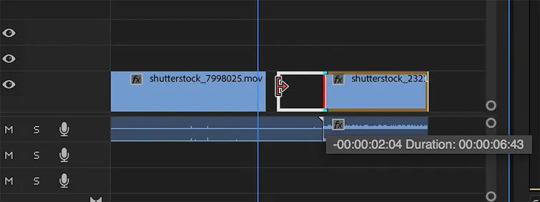
Copy: The action of making copies of clips with the intention of utilizing them elsewhere in the sequence but without affecting the original.
Paste: Adding a copied or cut out clip sequence which has been previously moved to a different position in the timeline to enhance pacing or storytelling.
Move: The action whereby clips are changed to other positions which in turn changes the order, the time will elapse, or the flow of the story.
Types of Cuts
There are two types of cuts, each with its function, serving to create the scene’s mood, continuity and sharply devised structure.
Standard Cut / Hard Cut
youtube
Definition: A transition, that means from one shot to another, probably due to change of scene. Purpose: This continues to keep it simple and never gets in a tangled position that is confusing; further, it advances the story nicely.
Match Cut / Graphic Match Cut
youtube
Definition: Establishes a link from one shot to the other by using a shape or colour overlap. Purpose: Brings together two sequences and joins them in such a way that one sequence sets the scene for the next.
Jump Cut
youtube
Definition: A technique in which the action of a film is broken and cut immediately to the same scene later with the missing meanwhile action leave out. Purpose: Used to relate energy or intensity such as time or to pick up tempo, up the speed.
Cut on Action
youtube
Definition: A hit made while the subject is still in movement (like turning), at the time the scene changes. Purpose: Maintains continuity but ensures that the movement of one plan to the other is natural.
J-Cut / L-Cut
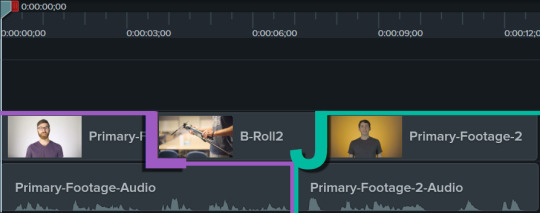
Definition: In a J-Cut the sound from the next scene begins before the scenes actually begin to play out before the viewers. This sort where the audio from the next scene being joined to the visual from the current scene is called L-Cut. Purpose: Is very smooth, used where the narrative has to move from one point to another particularly in dialogue.
Cross Cut / Parallel Cutting
youtube
Definition: Interchanges between two parallel events that are simultaneously occurring in two different locales. Purpose: Establishes irony or continuity, and often makes people feel that something is happening simultaneously.
Cutaway
youtube
Definition: An short form for something which relates to the main procedure but does not always occur in it. Purpose: Includes additional information that can be useful in understanding some part of the scene on the screen.
Montage cut:
youtube
Definition: It's groups of smaller/short clips for showing time lapse or progress of something and have sound effect to make it more interesting.
Purpose: It makes scene more interesting and emotional showing the journey, shows growth and time passing.
Morph cut:
Definition: A cut happening between two shots look natural, and smooth, feels like that no cut is been done.
Purpose: Makes the shots smoother, fixing jump cuts to blend the shot to remove mistake and used for films to make documentary, news and etc.
0 notes
Text
My Ideas for the Animation (Each Hat)
I feel like using a mascot or character to tie the different segments together would indeed work well within the parameters of the brief, since it says we need to have Visual Coherence, Experimental Approach and also Conceptual Clarity. I would be employing match cuts as my preferred transition to have a seamless and interesting transition between the different scenes.
BLUE HAT: Introduction to BDD - Cutout Animation
In the first 5 seconds of the animation, I'll include a title and introduce the animation and the topic covered in it.
WHITE HAT: Factual Information - 3D
Since BDD is a clinically proven disorder and is still being actively studied, I want to give the idea of someone being tested, like a lab rat. There's a lot of statistical and quantitative data on BDD as a whole, and because of that, sometimes researchers might not consider the human aspect of these people.
Having a person standing in the middle of the screen while a few people dressed in lab coats study them, without paying attention to their sad expressions, would be a good way to show that BDD is a clinical disorder that is being studied and researched. It will also show how this person has a negative body image through contextual clues in the background and through the person's body language.
RED HAT: Emotional Aspects - 2D Animation
Negative body image and BDD specifically have a lot of emotional aspects to them. It's a disorder that affects a person's mood in a drastic way. Extreme emotions can arise for people suffering from BDD, so I definitely want to incorporate how this character feels.
The screen zooms into the character in the middle as a spotlight shines on them while the background slowly fades away into black. We see tears falling from the eyes of the character, showing their emotional distress caused by their negative body image.
BLACK HAT: Negative Consequences - Charcoal Animation
The consequences of poor body image and BDD, in general, are plentiful, with a low quality of life being one of the main drawbacks. You are less sociable and less confident.
This can be depicted well in the animation. As the camera pans out, it shows the character on a bed (top-down shot). The character is restless and is tossing and turning in their sleep, which indicates the low quality of life they are experiencing as a result of the stress. There can be several added effects that personify the voices in the character's head.
YELLOW HAT: Positive Effects - Collage Animation
There are multiple benefits to having a positive view of yourself. People suffering from BDD have a hard time doing this, but it isn't impossible. People with BDD can grow to love themselves and enjoy the benefits of a positive body image.
To show this in my animation, the character slowly starting to get up and socialize. I would like the other characters to be shown as simple shapes rather than humanoid, to subtly say that the character doesn't care what they look like. To him, they're all unique and different. He has learned to accept himself and also others around him.
GREEN HAT: Creative Solutions - 3D/2D mix
There are not many solutions to BDD, but new innovations can definitely aid people who suffer from this. Aside from CBT, we can think ahead and think about other ways people could get help, specifically from AI.
I feel like it would be pretty creative if the character were to appear in a therapist's room, lying down, next to a robot acting as the therapist. This symbolizes the AI aspect of psychotherapy and how it could be used to aid people who aren't comfortable with other people—personalized therapy, basically.
0 notes
Text
Types of Cuts & Transitions
CUT ON ACTION: A cut that happens mid-action
CUT AWAY: Cuts to an "insert shot" of something, whether in the scene or somewhere else.
CROSS CUT: Cutting back and forth between locations/events (e.g. phone conversations)
JUMP CUT: Cutting within the same shot, usually to show the passive of time. Creates a jerky/jarring effect.
MATCH CUT: Cutting from one shot to a similar shot that is connected in some way (visually, compositionally, audio, etc.)
FADE-IN/FADE-OUT: Dissolving to/from black
DISSOLVE: Blending/fading into another shot. Can represent passing of time.
SMASH CUT: Intense transition (e.g. going from intense to quiet)
IRIS: Circle that closes in, to mimic eyes closing in.
WIPE: Screen wipes across.
INVISIBLE CUT: Cutting with the illusion to make it seemless, but really it's occuring in black screen, or in motion, or when an object passes across the frame.
L-CUT: When audio from one shot carries over to next shot. (can be used often for minor things like conversation audio)
J-CUT: When audio from the next scene plays in its previous scene.
Source: RocketJump Film School - Cuts & Transitions 101
0 notes
Text
Mastering Your Golf Swing: 3 Easy Steps to a Professional Swing Plane
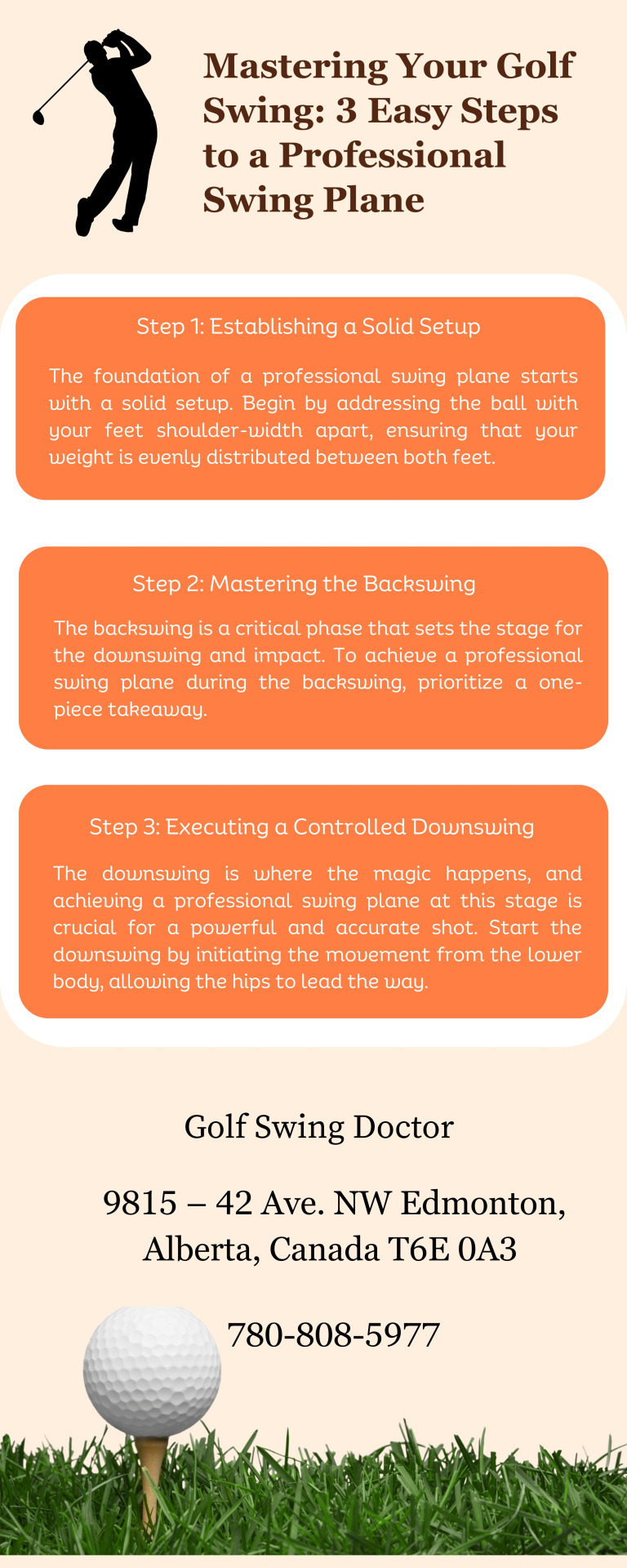
A powerful and consistent golf swing is the Holy Grail for every golfer, whether you're a seasoned pro or a weekend warrior. One key element that can significantly improve your game is achieving a professional swing plane. The golf swing plane refers to the imaginary surface that your club head travels along during the swing. A precise and well-executed swing plane can lead to greater accuracy, distance, and overall performance on the golf course. In this guide, we'll explore three easy steps to help you achieve a professional swing plane and elevate your golf game to new heights.
Step 1: Establishing a Solid Setup
The foundation of a professional swing plane starts with a solid setup. Begin by addressing the ball with your feet shoulder-width apart, ensuring that your weight is evenly distributed between both feet. The ball should be positioned in line with the instep of your lead foot, allowing for proper alignment. As you take your grip, make sure your hands are positioned directly below your shoulders, promoting a neutral and natural stance.
Next, focus on maintaining a straight back with a slight tilt at the hips. This posture sets the stage for a more efficient and on-plane swing. Visualize a straight line running from the club head through your hands and up to your shoulders – this alignment is crucial for achieving a consistent swing plane. Take the time to perfect your setup, as it forms the basis for a professional swing that can be repeated with accuracy.
Step 2: Mastering the Backswing
The backswing is a critical phase that sets the stage for the downswing and impact. To achieve a professional swing plane during the backswing, prioritize a one-piece takeaway. Ensure that your club, hands, and arms move together as a cohesive unit. This promotes a smoother transition and helps keep the club on the desired plane.
As you initiate the back swing, focus on turning your shoulders while maintaining a stable lower body. Avoid excessive lateral movement, as it can lead to inconsistencies in your swing plane. A common mistake is over-rotating the club face, resulting in an open or closed position at the top of the back swing. To counter this, practice a controlled and controlled rotation of the shoulders, keeping the club face square to the target line.
Step 3: Executing a Controlled Downswing
The downswing is where the magic happens, and achieving a professional swing plane at this stage is crucial for a powerful and accurate shot. Start the downswing by initiating the movement from the lower body, allowing the hips to lead the way. This sequence promotes a natural inside-out swing path, contributing to a more on-plane delivery to the ball.
Focus on maintaining a smooth and controlled tempo throughout the downswing. Avoid the temptation to rush, as it often leads to a loss of control and balance. As you approach impact, ensure that your hands lead the club head, allowing for a crisp and well-connected strike. The goal is to deliver the club head to the ball on the same plane established during the back swing, resulting in a consistent and professional swing.
Conclusion:
Achieving a professional swing plane is within reach for every golfer, regardless of skill level. By mastering the basics of setup, back swing, and downswing, you can build a foundation for a repeatable and effective golf swing. Consistent practice and a focus on these fundamental steps will lead to improved performance on the course. Elevate your game and experience the joy of a professional swing plane with Golf Swing Doctor – the key to unlocking your full golfing potential.
#professionalswingplane#golflessonsblogs#golfgame#swingebook#3easystepsbook#sportsbook#ebook#golfbook#onlinegolftips
0 notes